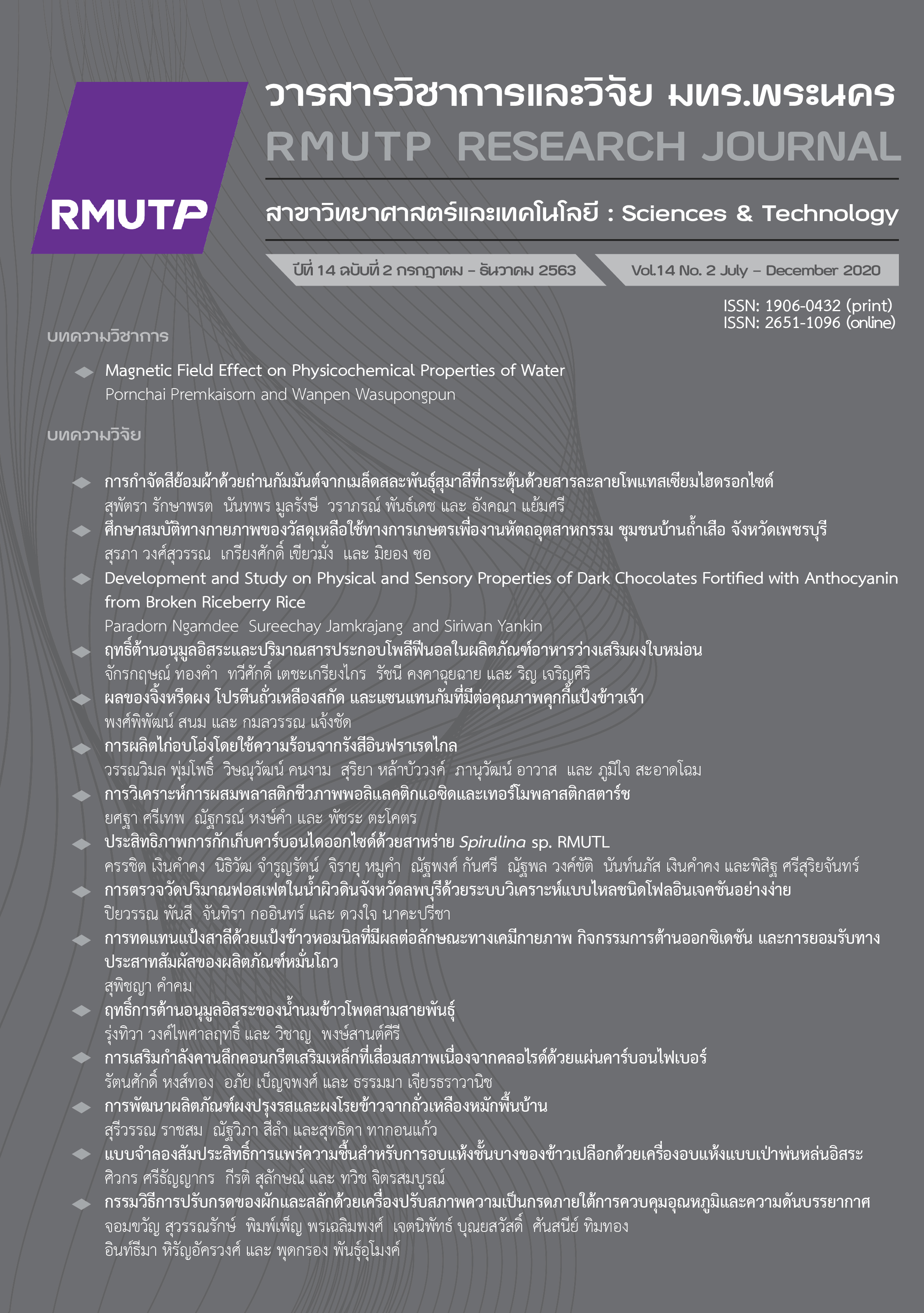Acidification Processes of Carving Vegetable Using Acid Conditioning Machine Under Temperature and Pressure Control
Main Article Content
Abstract
This research aimed to study the acidification processes of carving vegetable using acid conditioning machine under temperature and pressure control which was developed in this study. Four acidification procedures were done at normal atmospheric pressure (method 1), under vacuum pressure for 10 (method 2) and 20 min (method 3) and vacuum pressure alternating with normal atmospheric pressure for each of 1 hour. There were two main parts of acid conditioning machine including the temperature controller inside the pickle tank and heat conductor tank, and the pressure controller inside the pickle tank. The pickling temperature was stabled at 40oC under the pressure of 0.5 Bar. PLC (Programmable Logic Controller) program was used to write the ladder for controlling all processes and display through SCADA system. The results showed that the acidification method by soaking the carved-rose carrot under vacuum pressure alternating with normal atmospheric pressure showed the shortest time to equilibrium by 7 hours. Then, the carved-rose carrot was packed in the glass jar followed by sterilized in boiling water for 15 minutes and stored at room temperature for 7 days. Total bacteria count, Escherichia coli and Yeast-mold were not exceeded than the standard limit. Staphylococcus aureus was not detected throughout the storage periods.
Article Details

This work is licensed under a Creative Commons Attribution-NonCommercial-NoDerivatives 4.0 International License.
ลิขสิทธ์ ของมหาวิทยาลัยเทคโนโลยีราชมงคลพระนครReferences
J. Suwannarak., P. Phanumong and N. Rattanapanone, “Physiological changes of fruit and vegetable carving,” Chiang Mai University Journal of Natural Science, vol 13, no. 1, pp. 77-86, 2014.
J. Suwannarak., C. Phuenpiphop, N. Rattanapanone, S. Thimthong, S. Chantakul and P. Phanumong, “Vegetable-craved processing in Hermetically seal container,” RMUTP Research Journal, vol. 11, no. 2, 2017.
W. Yuenyongputtakal. “Factors Influencing on Dewatering by Osmotic Dehydration of Fruits and Vegetables,” Burapha Science Journal, vol. 18, no 1, pp. 226-233, 2013.
Bacteriological Analytical Manual (BAM). (2018, Feb 10). Chapter 3: Aerobic Plate Count. [Online]. Available: https://www.fda
.gov/food/laboratory-methods-food/bam-aerobic-plate-count.
Bacteriological Analytical Manual (BAM). (2018, Feb 10). Chapter 12: Staphylococcus aureus. [Online]. Available: https://www.
fda.gov/food/laboratory-methods-food
/bam-staphylococcus-aureus.
Bacteriological Analytical Manual (BAM). (2018, Feb 10). Chapter 4: Enumeration of Escherichia coli and the Coliform Bacteria. [Online]. Available: https://www.fda.gov
/food/laboratory-methods-food/bam-4-en
umeration-escherichia-coli-and-coliform-b
acteria.
American Public Health Association (APHA). “Compendium of method for the microbiological of food: Chapter 20,” 4th ed. American Public Health Association, Washington D.C., USA, 2001.
N. Sun, H. Liu, X. Zhang, H. Wang, S. Liu, P. Chen, W. Yu and K. Liu, “Physical, chemical properties and structural changes of Zaodan pickled by vacuum decompression technology,” Korean journal for food science of animal resources, vol 38, no. 2, pp. 291–301, 2018.
J. KerdKuan, “Mango pickles with hydrostatic pressure from research to industry,” Technology Chaoban, vol. 19, no. 401, pp. 26, 2007.
K. Thiminkul, “Research and development of vegetable pickling machine by using the hydro static process and mixed starter solution,” Research and development report, Department of Agriculture, 2017.
A. Wiluntho, A. Authapho and C. Nuntheesri. “Production of pickled mango using hydrostatic pressure,” Special Problems Bachelor of Science, King Mongkut's University of Technology Thonburi, Bangkok, 2002.
Ministry of Public Health, “Announcement from the Ministry of Public Health (Issue 355). Food in hermetically sealed containers,” Gazette General Announcement, vol. 130, Jul. 2013.


